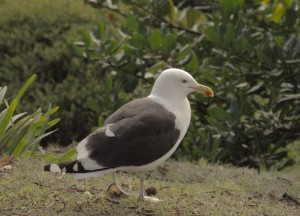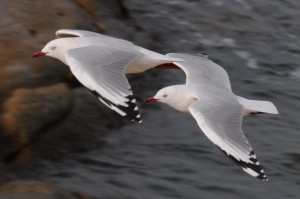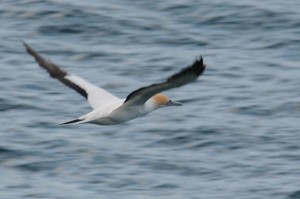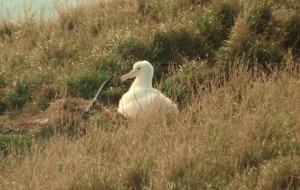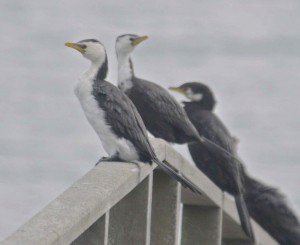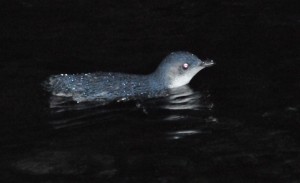These are some of the New Zealand water birds I saw in New Zealand in 2006, 2008 or 2010 as part of the Alma College New Zealand Experience, which I flunked three times. By my definition, water birds are birds that hang out by or in the water most of the time. I have divided the water birds up into three not-so-scientific categories: veggivores, eat-everything-avores and fishivores.
Below are some photos and tidbits based on my trips, the Field Guide to New Zealand Wildlife, an excellent photographer in NZ named Matt Jones and Mike Bishop, a.k.a. BirdNerd, from Alma College.
Veggivores: otherwise known as herbivores and vegetarians, are birds that get their food from plants.
Black swans were originally confined to Australia but were brought to New Zealand in the 1860s to give Kiwis a big birdie to hunt. Black swans can be found throughout NZ munching on aquatic vegetation.

According to the Field Guide to New Zealand Wildlife, New Zealand scaup are usually found in “large, deep bodies of water . . . and generally shun running water and marine environments.” I, of course, saw them in a river in downtown Churchtown diving in a narrow urban river. Hm. Anyway, these birds eat the shoots and seeds of aquatic veggies. They are called the New Zealand scaup because they are only found in NZ.
One of the things I like about the NZ scaup is that its head sometimes looks more green than black.

The paradise shelduck is also a veggivore and can be found munching on turf in urban areas, on grain in farm fields, and pretty much everywhere in NZ. The male paradise shell duck is mostly grey.

The female looks completely different.
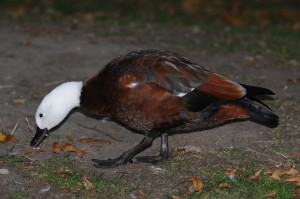
The takahe is a rather snobbish type of vegetarian, its primary interest being the tussock plant, ferns being secondary. These heavy-bodied birds number only 100 in the wilds of New Zealand, which is why this photo was taken in a bird preserve in Te Anau on the South Island.
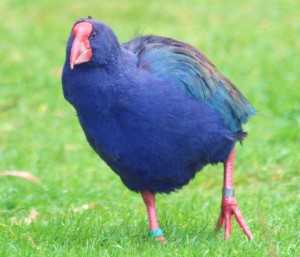
Eat-anything-a-vores, also known as omnivores. The following NZ birds eat a variety of things.
Mallard ducks are found just about everywhere in New Zealand and, like the black swan, were introduced specifically to hunt. They eat aquatic plants, tadpoles, and insects. The hen mallard is drab.
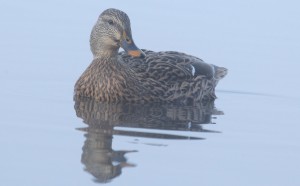
The male mallard is more colorful.
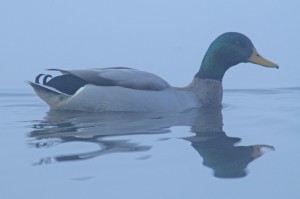
Cattle egrets eat worms, bugs, frogs, crickets, grasshoppers and pretty much anything else that’s small and filled with protein. These birds visit NZ every winter from Australia. I saw cattle egret twice while on Stewart Island.
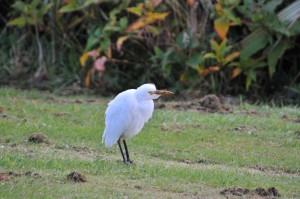
I put the royal spoonbill in this category of watery birds because they don’t eat fish or plants, rather, they eat snails, crustaceans and other crunchy tidbits of protein. There’s only a few hundred spoonbills in NZ and most go to the North Island, which is why it was nifty to spot this one while looking for royal albatrosses on the Otago Peninsula, South Island. It was far, far away.

The white-faced heron eats fish, bugs, mollusks, tadpoles, frogs and reptiles, which makes it the most omnivore of omnivores. We saw this white-faced heron along the shore near the Moraki Boulders on the South Island searching for food among the washed up kelp.

South Island Pied Oystercatchers eat mollusks, which include oysters, among other tasty things like chiton and limpets. They will also eat insects, grubs and earthworms. In my three visits to NZ, I saw these on Stewart Island, both in the water, and on the turf.
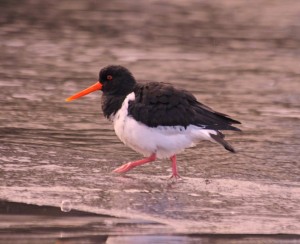
The other oystercatcher is the variable oystercatcher, and it’s called that because it can look all black, OR it can look a lot like the pied oystercatcher. In fact, there are pied variable oystercatchers, which just isn’t right if you ask me.
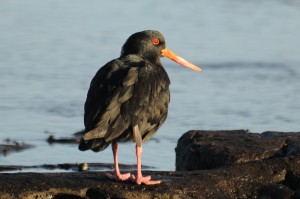
Pukekos are colorful birds that hang around wetlands and other wet areas Some folks call them purple swamphens. These birds primarily eat veggies but will eat bugs, frogs, and dead yucky stuff.
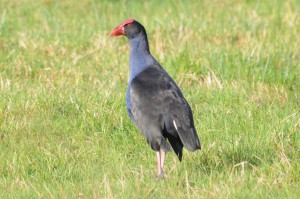
Kiwis eat fruit, seeds, worms, insects, slugs and snails. I wrote about a kiwi encounter on a blog posting and it was funny, so you should read it. Not now, of course. But after you’re done here. What’s nifty about the kiwi is that the egg laid by the kiwi is the largest egg per body size of any bird in the world. Sadly, no one has ever recorded the loud “ooooouch!” yelled out by the female kiwi while laying such a large egg.
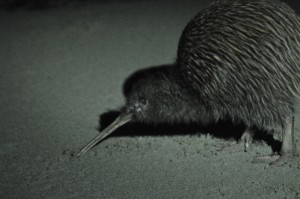
Black-backed gulls are well-named gulls that we saw throughout New Zealand. Even though I saw this one at the botanic garden in Dunedin, I put them in the water bird category because most people associate gulls (and bouys) with water. Like most gulls, these birds eat just about anything.
This is an immature red-billed gull hanging out outside the South Sea Motel on Stewart Island.
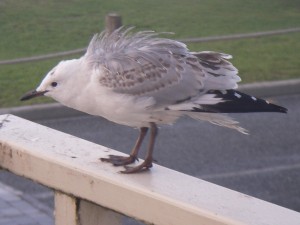
Wekas mainly eat seed, fruits and bugs, which they look for while poking around the ground.
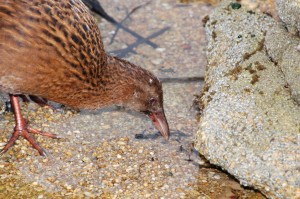
The wekas on Ulva Island, off Stewart Island, are friendly and curious and will approach people like me who are willing to turn over rocks to help them find food.
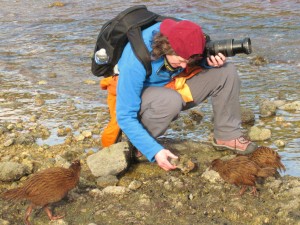
Fishivores make up the final group of water birds. These, of course, are birds that like fish. Most prefer raw fish to broiled, baked or fried.
Australasian gannets are found in Australia and also on small offshore islands around the North Island of New Zealand. That’s why it was rather nifty to see one flying by the Royal Albatross Colony outside Dunedin on the South Island. These birds plunge-dive from high enough up to give most birds a concussion. They eat small fish.
White-fronted terns like to plunge-dive, too. This one is likely recovering from one too many such dives.
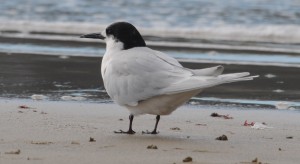
The Royal Albatross has wings that can be 9.8 feet long, which they need because they hang out on the open ocean except to breed and raise their young. Unless you also hang out on the open ocean most of the time, the best place to see Royal Albatross is at the Royal Albatross Colony on the Otago Peninsula on the South Island. If you’re lucky enough to see an adult, it’s often through the enclosure at the top of the observation enclosure.

Royal albatross young require 8 months before they’re mature enough to be on their own. This fuzzy fella was observed at the outlook at the top of the Royal Albatross Colony, waiting for dinner to arrive.
In 2010, while crossing between Ulva and Stewart Islands, Matt Jones and his boat captain, Ty, stopped to call in some albatross for us. This is the Buller’s albatross.
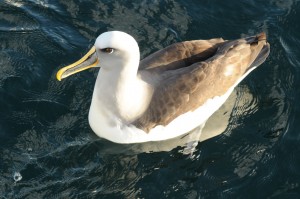
This is the shy albatross, which is less shy and more numerous than the Buller’s. This photo shows what happens when I stand on the side of a boat and the boat gets in the way of a good photo.
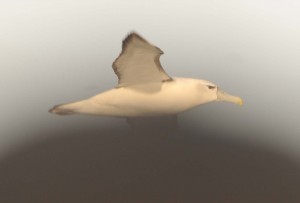
Here’s what a shy albatross looks like on the water.
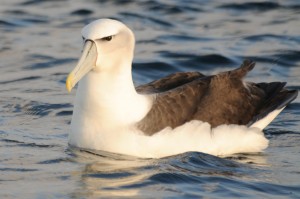
Little shags are also known as white-throated shags or little pied cormorants. Some people in Michigan refer to cormorants as water turkeys. Little, shaggy water turkey is too complicated, so we’ll go with little shag.
New Zealand is also home to the pied shag.

The spotted shag doesn’t look very spotty from a distance, but up close, the black spots on its grey wings are pretty uh, spotty.
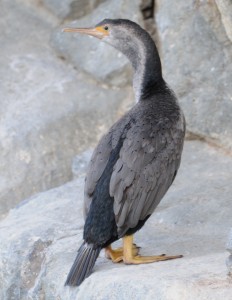
The Stewart Island shag is probably my favorite of the shags, in part because of its pink feet. Also, because there are variations to the Stewart Island shag. There’s this one.

This is also a Stewart Island shag.
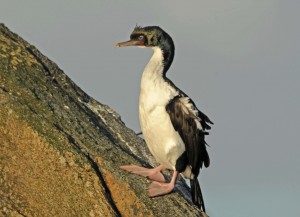
It’d be hard to say what’s cuter, though, the Stewart Island shag or the yellow-eyed penguin. I did a blog posting of the yellow-eyed penguin encounter. You should read about it. Not now, but when you’re done here.
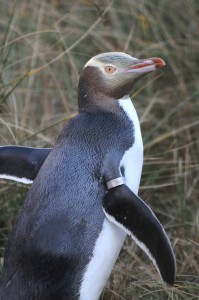
I also did a blog posting about blue penguins. They’re 16 inches long or high depending on if they’re swimming or standing. I’m sure you’ll be reading that at some point, too.
And that concludes the NZ watery birds I saw during my visits. Now you can read my blog postings. Or check out the NZ land birds. Or buy one of my photo books. Or check out Matt Jones’ photographs at mattjonesphotography.com.

